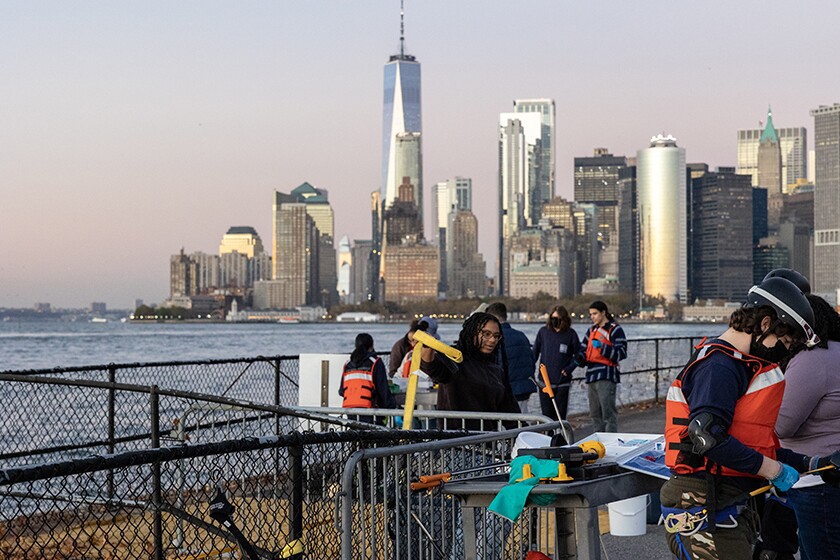
(Photographs by David Kidd)
The teenagers are collecting plastic bottles, foam packaging, fishing line and other marine debris that has washed up onto the rocks. The items are placed inside a large white pail then passed back over the fence to a group of waiting students. At one point, a long section of heavy rope is discovered, wedged into a deep crevice. A crowbar is handed down to aid in its removal.

The dozen or so students are members of the Harbor SEALs (Sea, Estuary, Air and Land), an after-school program at the Harbor School, a New York City public high school that happens to be located on a small island in the New York Harbor. The school’s curriculum focuses on marine science, technology and policy, preparing graduates for maritime careers or further study at the college level.

Occasional passersby stop to watch the students as they test the sample for pH and nitrates. An anomaly is quickly spotted. “The dissolved oxygen is abnormally low,” notes one of the testers. “And that’s not good for the creatures living in the harbor.” The Harbor SEAL’s work is more than a learning exercise. Their test results and accumulated data about the health of the harbor are made publicly available to all interested stakeholders.

From Military Outpost to Maritime School
Governors Island has served as a military outpost since the Revolutionary War. A succession of forts, officers' homes, headquarters and barracks have been added in the years since. In 1912, the Army Corps of Engineers more than doubled the island’s size, using fill taken from harbor dredging and the excavation from a new subway line. The installation was transferred to the Coast Guard in 1966.
Until its closure 30 years later, Governors Island was home to 3,000 full-time service members and an additional 1,500 daily commuters. In 2003, the federal government sold 150 acres of the property to the city and state of New York, leaving the remaining 22 acres to be owned and managed by the National Park Service. The island was opened to the public in 2005.

A Mission of Equal Opportunity
The Harbor School belongs to a network of 23 small, career-themed public schools in the city, collectively known as the Urban Assembly. Each of the schools has its own focus, including government and law, technology, software engineering and performing arts. Middle school students apply to the schools that feature their area of interest. But not everyone gets into their first choice.
Every student in the city has an equal opportunity to attend the Harbor School. There are no tests to take or aptitudes to demonstrate for admission. The school participates in a diversity plan with the New York City Department of Education which decides who will be admitted each year. “The mission of the school is to provide an opportunity to students that don't know that these opportunities exist,” says Principal Jeff Chetirko. “That's the mission.”

Only 140 new students make it to school on Governors Island each September. Attrition is low with both students and faculty, the principal estimating “maybe 15 percent teacher turnover over eight years.” The graduation rate is 92 percent, higher than the citywide average.
Before they applied, it’s safe to say most of the students had no idea that there is a maritime high school in the New York Harbor. PTA co-president Amy Koza is the anomaly. She has been bringing her 11th grader to Governors Island since he was two years old, which is how they came to know about the school. “When my son learned that they have professional diving, since the seventh grade, it’s all he wanted,” she says. “We’re so grateful to get a spot here.”
Learning and Working on the Water
There is only one way to get to the New York Harbor School, and that is by boat. Every morning more than 500 students, faculty and staff converge on the Battery Maritime Building in Lower Manhattan to catch the ferry. They come from all five boroughs by bus, bike, subway and on foot. The average commute to school is about an hour each way. Students coming from Staten Island take two ferries, morning and night.
Beginning with the 10th grade, students at the Harbor School choose from seven career and technical education (CTE) programs of study, including aquaculture, marine biology research, marine policy and advocacy, marine systems technology, ocean engineering, professional diving and vessel operations.

In addition to the clubs and classes, students get hands-on experience by working with many of the school’s partner companies, colleges and organizations. Chief among them is the Billion Oyster Project, also based on Governors Island and founded by a former Harbor School teacher and administrator. The group’s mission is to improve water quality by re-establishing the harbor’s lost oyster population. Students can participate in paid summer internships, and some take full-time jobs with the group after graduation.
While the Harbor School may be focused on maritime careers and study, students must also fulfill the normal requirements of any city high school. “We're a traditional high school that is expected to pass [state exams], and do everything that normal schools do,” says Principal Chetirko. “There's no other school in New York City that's doing this. There's nothing like this.”

A School Like No Other
Built of brick and three stories tall, the former Coast Guard building looks like any other high school of a certain age. But inside, a nautical theme shows itself. The wall of one hallway is lined with perfect renderings of 1,000 individual fish, each identified by its genus and a brief description. Classroom doors have portholes. A foghorn replaces the traditional bell. The school trophy case is dominated by a multitude of awards won in open-water rowing championships.
One classroom in particular is stuffed from floor to ceiling with bins, buckets and boxes, most of them slapped with nearly indecipherable, scientific sounding labels. Rows of small water tanks are stacked four high against one wall. Tangles of hoses, pipes, pumps and wiring are seemingly everywhere. Senior Arlo Kane is right at home here.
Arlo is a member of the SEALs club that monitors water in the harbor. His class is testing a special type of concrete, said to promote biodiversity in underwater applications. “This new material has a lot of promise promoting biodiversity,” he says. “Specifically, in the Hudson River.”
Its surface and chemical composition encourage the growth of oysters, corals and barnacles, adding strength and durability. Several samples of the material are stacked on a shelf, waiting to be submerged.

Many of the CTE classes take place at a second building on the other side of the island. The school’s fleet of boats — many with “Billion Oyster Project” painted on their hulls — are tied to a floating pier. Simulators for operating boats, racks of diving equipment and outboard motors in various states of disassembly all have space in this part of the campus.
Women at the Helm
The day after the Harbor SEALs conducted their water quality assessment, a dozen vessel operations students are heading out into the harbor aboard Virginia, a 29-foot landing craft, and Attractive Nuisance, the school’s 19-foot aluminum work boat. Their destination is the USS Intrepid, a decommissioned aircraft carrier docked along the west side of Manhattan. The Coast Guard is celebrating Veterans Day at the ship with search and rescue demonstrations and informational displays.

For many of the students, the highlight is a visit with Captain Zeita Merchant, who directs all Coast Guard missions in the Port of New York and New Jersey. “She’s kind of a big deal,” vessel operations teacher Aaron Singh tells the group.

“Maritime is a male-dominated field,” says Juliana. “We don't really have that many women that come into this field and want to … get dirty in the engine and all of that.” She has her sights set on college next year, the Coast Guard Academy being her first choice. At present, Juliana and her female classmates are outnumbered two to one. “[But] they are in every single one of our CTE programs," says Jeff Chetirko, the principal. “And they excel.”

Charting a Course for the Future
The New York Harbor School continues to grow and make room for more students. By September 2025, another of the former Coast Guard buildings will be refurbished and reconfigured to house 12 additional classrooms. A year after that, a swimming pool, gymnasium and four more labs will open in the first new building to go up on the island since the city took it over. Until then, diving students will continue to use the pool at the school’s original Brooklyn location. When work on the two buildings is complete, the student population could double in just a few years.
Jaylen Boyce is a senior in marine biology research and a member of Harbor SEALs. He doesn’t take the Harbor School for granted. “Not many people go to school on an island and take a ferry and do the things that we get to do,” he says. Chetirko has his own point of view. “I'm the only principal in New York City that has to worry about a field trip for 500 students every day.”

Related Articles












